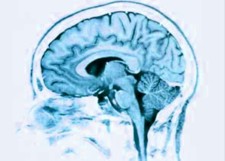 Well, OK, I haven’t really donated my body to science! But I’ve done the next best thing – I’ve loaned my brain to research. How did this come about?
Well, OK, I haven’t really donated my body to science! But I’ve done the next best thing – I’ve loaned my brain to research. How did this come about?
Ever since I attended the undergraduate chemistry research conference last May, I’ve been looking for different research opportunities and ways students can get involved. On-campus psychology students are a rich source of research subjects and participants, but we at AU don’t often get these kinds of opportunities. So when I saw an ad in See, our local entertainment magazine, I decided to check it out. The ad stated, “Brain neurobiology research program at U of A seeks volunteers for research project,” on the topic of PMS. I’ve had previous struggles with depression, and have often wondered whether any of these were linked to pre-menstrual syndrome, so I felt I might be a suitable candidate for this study.
The following week, I received a call from a summer student at the U of A who was helping coordinate the research. She asked me a few questions to determine if I fit the requirements, then set up an appointment to do a detailed telephone intake with me several days later. At the intake interview, she explained briefly what the research was about. The purpose of the study is to measure brain GABA (Gamma-aminobutyric acid) levels in premenstrual dysphoric disorder (PMDD). It is based on previous research evidence that suggests a link between brain chemicals in the GABA system and the occurrence of emotional premenstrual symptoms. When I was working on my research project for biological psychology (Psyc402), I had initially investigated a link between GABA levels and stress, so this research topic was already somewhat familiar to me, increasing my desire to become involved.
The study consists of a control group with no PMDD symptoms, a group with PMDD symptoms and history of depression, and a group with PMDD symptoms and no history of depression. Participants are asked to keep a daily record that includes physical, mental and emotional state, and are required to note both ovulation and menstruation dates throughout the period of the study. Brain levels of GABA will then be measured by using an MRI machine. Hormone levels will also be measured through blood samples.
The principle researcher is Jean-Michel Le Melledo, M.D. Le Melledo has been awarded several Canadian Institute for Health Research grants for his projects. Another long-time research project he has been involved with is that of panic disorder, and he is currently looking at the relationship between female hormones and panic disorder. A link between anxiety and GABA levels is also part of that study, and the relationship between GABA and PMDD is a natural outgrowth of these previous investigations.
At the initial telephone intake, I was reassured that proper ethical and confidentiality procedures were being followed, and that I would have access to a copy of my information at the end of the study. Complete results will not likely be available for several years, due to the overall length of the study period. I was asked a lot of questions, some of them quite detailed and quite personal in nature. However, I understood that the goals of the study required this information, and that this level of detail was required to determine whether I was eligible to participate. The summer student explained that once the researchers had screened the telephone interviews, they would decide whether to include me in the next phase of the study. She asked me to call them when my next menstrual cycle began so that they could set up an appointment for the second interview.
When I told my daughters about getting involved in this project, they expressed surprise that researchers would have access to an MRI so easily, given the long waiting list for patients in Alberta wishing an MRI scan. One of them relayed to me a story she had heard about a horrible MRI accident. Although no metal objects are to be in the testing area, someone had left a metal oxygen tank in the MRI room. A six year old boy was in the MRI machine, and when the machine was turned on, the powerful electromagnet caused the tank to fly across the room, fracturing his skull and killing him. I recalled that during the telephone intake, I had been asked a lengthy series of questions about whether I had any metal implants or devices. Upon doing further research, I discovered that MRI’s are considered very safe, but freak accidents have occurred when the machine has come into contact with metal. Items as small as paper clips or hairpins have caused serious damage, and patients have been injured by things such as tiny iron filings in their eyes that they were unaware of. After reading about some of these incidents, I began to wonder whether I wanted to place myself at risk for the sake of scientific research! Common sense tells me that risks are minimal, and that MRI’s are used millions of times safely every year – but I could not help but worry.
The second interview was held at the University Hospital, with one of the researchers. She advised me that it would take a couple of hours, and gave me detailed instructions on how to find the brain neurobiology research office in the hospital. By the time I arrived for my interview, it was already almost 8 PM, and the neurobiology section of the hospital was dark and quiet. In spite of the instructions, I had a hard time finding the office, only encountering locked doors and dim corridors. Occasionally I’d run into another human being, but none of them seemed to know exactly where this research office was located. At the end of each darkened hallway I would encounter doors marked “authorized personnel only,” or “danger” signs of some type.
With visions of flying oxygen tanks filling my head, I was getting a bit spooked and wondering whether this was legitimate or even worth my time, when I finally stumbled upon the right door number. It was locked. I turned to leave, when suddenly the door opened. It was Janette, the researcher. She advised that she had been looking for me and waiting, and then escorted me down another long dim corridor to her office.
At this interview, questions became even more detailed and personal, and Janette explained more about the study. She told me that many of the participants suffer extreme PMDD symptoms, to the extent that their lives are significantly hampered, and explained that at the end of the study participants would be offered a treatment option. After going through my information, she concluded that I didn’t fit in the extreme group, but that once I had kept the diary for a month, we would have a better picture of where I did fit in. She reassured me that I could withdraw from the study at any time.
I was again asked a series of questions about potential pieces of metal on my person, along with questions about being uncomfortable in enclosed spaces. This question gave me pause, since I do have slight claustrophobia under certain circumstances, but I reassured her that I would be fine inside the MRI machine. She explained that the procedure is very safe, and that it would involve being inside the MRI scanner for about one hour on two occasions during the study. The actual technique used will be MRS, since rather than supplying a brain image like the MRI does, a line graph will be produced to indicate GABA levels. My involvement in the study itself would last for about six months. Janette also told me that although they must conduct initial screening interviews with at least a hundred women, they are likely only going to have about 25 women in each group, due to funding limitations.
At the end of the session, Janette gave me several monthly calendars and showed me the various ways I would note my daily emotional and mental state. She also gave me a package of ovulation test strips and explained how I was to test urine samples to determine ovulation date. As I left the hospital, I was feeling somewhat ambivalent. On the one hand, my involvement in the project would require time and effort, and I certainly don’t need any more demands on my time. But on the other hand, its a marvelous opportunity to actually see how a university research project is conducted firsthand – and I know I’ll learn a great deal from the experience.
During the past few weeks the biggest challenge has been remembering to fill in the calendar every day, but its been quite enlightening to look at my daily pattern of emotional states. The calendar also allows for additional information to be added regarding external stress factors that may contribute to emotional changes, and I’m already noting a clear pattern between negative emotional states and incidents occurring within my family, among colleagues, and at work – so this is an excellent way to identify situations and people that I should avoid if I want to remain stress-free.
When I look at the sheer volume of information I’m generating for the research team, I have renewed respect for the amount of work and effort that goes into conducting a research study and interpreting the results. Even the urine testing process is an educational (although somewhat messy) procedure that enhances my admiration for what laboratory technicians do. I also have increased respect for people who get involved as research subjects, who are willing to allow their bodies and brains to be prodded, poked, tested and investigated in the name of science. I won’t know if I’m a suitable candidate to remain in the project until the first cycle has been completed, so I am not worrying yet about the MRI experience. I’m grateful, however, that I decided to get involved, since I’ve already had the opportunity to learn more about research – valuable knowledge which I hope to soon put to good use in research projects of my own.
Further Reading:
Six year old killed during MRI:
http://www.mercola.com/2001/aug/15/mri.htm
Can metal detectors cut MRI accidents?
http://wink.subportal.com/health/Health_Biz/Therapy_Procedures/MRI_Scans/501868.html
Fighting panic with female hormones
http://www.expressnews.ualberta.ca/expressnews/articles/news.cfm?p_ID=297&s=a
Two profs tackle anxiety:
http://www.expressnews.ualberta.ca/expressnews/articles/news.cfm?p_ID=1621&s=a
It isn’t all in your head/Female hormones and anxiety:
http://www.ahfmr.ab.ca/publications/newsletter/Fall01/fall.www/inside/head.feat.htm
Cortical y-Aminobutyric Acid (GABA) Levels across the menstrual cycle in healthy women and those with premenstrual dysphoric disorder:
http://www.courses.fas.harvard.edu/~psy1204/Readings2003-04-22/Menstral_GABA_Mood.pdf
Debbie is a native Edmontonian, and a single parent with four daughters. She has worked as a professional musician for most of her life, and has enjoyed a rich variety of life experiences – with many more to come! Debbie is working towards an eventual doctorate in psychology, and currently serves as the president of the Athabasca University Students Union.


